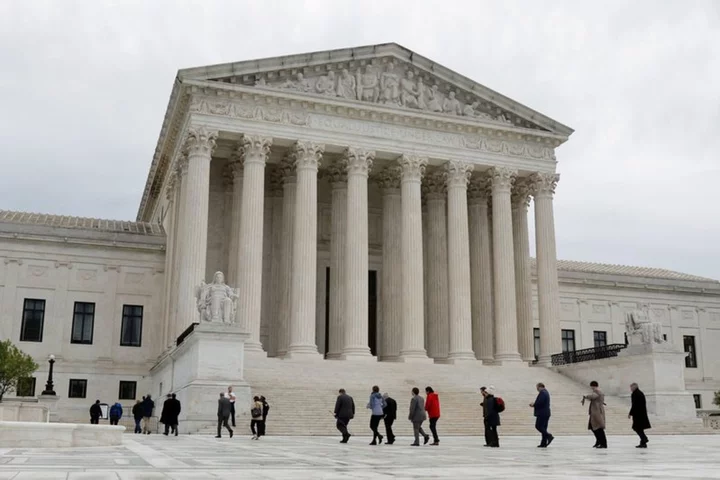By John Kruzel and Andrew Chung
WASHINGTON The U.S. Supreme Court has wrapped up another term in which its conservative justices flexed their muscles, following up major abortion and gun decisions last year with rulings that rejected affirmative action in college admissions, curbed LGBT rights and blocked President Joe Biden's student debt relief plan.
With cases on issues including gun rights already lined up for its next term, beginning in October, the court could once again steer the law in a rightward direction - facilitated by Republican former President Donald Trump's appointment of three justices who built a 6-3 conservative majority.
The liberal justices, including Biden's appointee Ketanji Brown Jackson, found themselves in the role of the dissenting minority in some of the nine-month term's biggest cases.
The court on Thursday struck down race-conscious admissions programs at Harvard University and the University of North Carolina, effectively prohibiting affirmative action policies long used to increase the number of Black, Hispanic and other underrepresented minority students on campuses. It found that policies like those at the two elite schools violate the U.S. Constitution's 14 Amendment promise of equal protection under the law.
On Friday, the court dealt a blow to LGBT rights by ruling that the Constitution's First Amendment free speech protections allow an evangelical Christian web designer who objects on religious grounds to gay marriage to refuse to provide services for same-sex weddings - despite a state anti-discrimination law.
Also on Friday, the court blocked Biden's plan to cancel $430 billion in student loan debt. The conservative justices invoked the "major questions" doctrine, a muscular judicial approach that gives judges broad discretion to invalidate executive agency actions of "vast economic and political significance" unless Congress clearly authorized them.
In those cases, the conservative justices were unified in the majority and the liberal justices dissented.
"The term will be most remembered for the decisions of the last couple of days that moved the law in a dramatically conservative direction," said Erwin Chemerinsky, dean of the University of California Berkeley Law School, referring to the affirmative action, web designer and student loans rulings.
"All were 6-3 and again show the impact of President Trump's three picks for the court," Chemerinsky added.
The court on May 25 also put another dent in the U.S. Environmental Protection Agency's regulatory reach, embracing a stringent new test for declaring wetlands protected under a landmark federal anti-pollution law. In that case, the liberal justices were joined by one conservative justice, Trump appointee Brett Kavanaugh, in dissenting on the new test.
SOME VICTORIES FOR THE LIBERALS
Chemerinsky cited some victories for the liberals during the term. These included the court finding that Alabama violated a federal law against discrimination in voting, throwing out a challenge to federal preferences for Native Americans and tribal members in the adoption or foster care placements of Native American children, dismissing a challenge by Texas to Biden immigration policy and rejecting a legal theory that stood to hand virtually unchecked power to state legislatures to establish rules concerning federal elections.
A key moment for the court - letting its conservative majority further exert its clout - came when Justice Amy Coney Barrett, Trump's third appointee, was confirmed by the Senate in 2020, replacing the late liberal Justice Ruth Bader Ginsburg.
The court on consecutive days in June 2022 expanded gun rights and overturned the landmark 1973 Roe v. Wade ruling that had legalized abortion nationwide.
Still, with the addition of Jackson, there were fewer rulings in which the conservatives were on one side and the liberals were on the other this term compared to last - five versus 14.
"This shows the court with the addition of Justice Jackson moved away a bit from ideological split decisions this term, although the court split ideologically in some of its most important decisions," said Adam Feldman, a legal scholar who tracks court data on his blog Empirical SCOTUS.
The court has several important cases in their coming term.
The justices on Friday agreed to decide whether a 1994 federal law that bars people under domestic violence restraining orders from possessing firearms violates the Constitution's Second Amendment. The justices will hear an appeal by Biden's administration of a lower court's ruling that found that the law ran afoul of the Second Amendment's "right to keep and bear arms" because it fell outside "our nation's historical tradition of firearm regulation."
The case involves a Texas man charged with illegal gun possession while subject to a domestic violence restraining order after assaulting his girlfriend.
The court also has taken up a case involving commercial fishermen that could further undercut the regulatory power of federal agencies, as well as a constitutional challenge to the Consumer Financial Protection Bureau's funding structure.
(Reporting by John Kruzel and Andrew Chung; Editing by Will Dunham)

